Characterization of E-cadherin expression in normal mucosa,dysplasia and adenocarcinoma of gastric cardia and its influence on prognosis
INTRODUCTION
Gastric cardia adenocarcinoma (GCA),which has been classified as type II adenocarcinoma of the esophagogastric junction in western countries[1],is of similar geographic distribution with esophageal squamous cell carcinoma in China[2],and even referred as "sister cancer" by Chinese oncologists.In contrast to esophageal squamous cell carcinoma,the incidence for GCA is increasing worldwide[3,4].Most GCA patients lack early warning symptoms,and>90% of patients are diagnosed at an advanced stage,resulting in poor prognosis,with<20% 5-year survival[5,6].Obviously,early detection for GCA is crucial in decreasing the high mortality.Identification of unique molecular biomarkers at the early stage of GCA is crucial for screening high-risk individuals and early detection of GCA.Unfortunately,the molecular mechanism of human gastric cardia carcinogenesis is largely unknown.
Accumulated evidence indicates that E-cadherin protein,a member of the cadherin family encoded by the
gene,may play an important role in intercellular adhesion,maintaining the stability of epithelial structure and function,cell polarity,and regulating intracellular signaling pathways[7].Reduced expression of E-cadherin has been reported as a molecular biomarker of a cellular process called epithelialmesenchymal transition,which is often associated with cancer progression[8].The latest studies have indicated that decreased expression of E-cadherin is involved in many different types of cancer[9-11].However,E-cadherin expression in GCA has not been well characterized.
2.Two daughters: According to the Opies, in the manuscript version of 1695 the sisters are stepsisters, the beautiful younger girl being the daughter of her father s first wife, as in Cinderella. This was doubtless the relationship in the traditional story; but Perrault probably altered it to make the situation less like that in the Cinderella story (Opie 1974, 100). Other variants17 of the tale, such as Mother Holle, maintain the stepfamily relationships.Return to place in story.
However, at last the peas were gathered and shelled, and the fire lighted, but then they had to be carefully counted, since the old woman declared that she would cook fifty- four, and no more
In the present study,we detected the expression of E-cadherin in GCA,precancerous lesions and normal mucosa.We also evaluated the relationship of E-cadherin expression and survival of GCA.
MATERIALS AND METHODS
Patients
All the patients were enrolled from the 500000 esophageal and gastric cardia carcinoma databases (1973–2020) established by the State Key Laboratory for Esophageal Cancer Prevention &Treatment and Henan Key Laboratory for Esophageal Cancer Research of the First Affiliated Hospital of Zhengzhou University(Zhengzhou,China).GCA patients were enrolled in the present study according to the following criteria:(1) Patients were diagnosed with GCA by postoperative histopathology;(2) Patients had tumors located in the esophagogastric junction;(3)Patients had no other malignant tumors except for GCA;(4) Patients received no chemotherapy or/and radiotherapy before surgery;and (5) The tissue samples of the patients were available.The exclusion criteria were:(1) Pathological type was not adenocarcinoma;(2) Clinicopathological information was incomplete;and (3) patients had received preoperative radiation or chemotherapy.A total of 4561 patients with GCA were enrolled in the study (Table 1).In addition,208 matched adjacent normal epithelial tissue and 156 dysplasia lesions were selected.
Gastric cardia adenocarcinoma (GCA),which has been classified as type II adenocarcinoma of the esophagogastric junction in western countries,is of similar geographic distribution with esophageal squamous cell carcinoma in China,and even referred as"sister cancer" by Chinese oncologists.The molecular mechanism for GCA is largely unknown.Recent studies have shown that decreased expression of E-cadherin is associated with the invasion and metastasis of multiple cancers.However,the Ecadherin expression has not been well characterized in gastric cardia carcinogenesis and its effect on GCA progno sis.
Histopathological diagnosis
Histopathological diagnoses for normal mucosa,dysplasia and adenocarcinoma of the gastric cardia were made according to established criteria[12].The normal gastric cardia mucosa,composing of a single columnar epithelium and mucous glands composed only of mucous cells;dysplasia,neoplastic feature including nuclear atypia and/or architectural abnormalities confined to the gastric cardia epithelium,without invasion;GCA,invasion of neoplastic gastric cardia cells through the basement membrane.
Immunohistochemical staining and evaluation
Lastly,we found that in the GCA patients with negative lymph node metastasis,positive expression of E-cadherin protein indicated better survival than negative expression.The difference in E-cadherin expression can further stratify the prognosis of patients with negative lymph node metastasis,indicating that E-cadherin protein expression may be a promising prognostic biomarker for non-surgical GCA patients.It is well known that lymph node metastasis is a useful indicator for poor survival in almost all cancer patients,including GCA.However,clinically,GCA patients with negative lymph node metastasis also showed different survival.E-cadherin protein expression may shed a light on these phenomena.
According to the staining intensity,the results were categorized as:0 points,no staining;1 point,light yellow;2 points,brown yellow;and 3 points,tan.According to the ratio of the positive cell number,they were scored as 0 (<10%),1 (11%-25%),2(26%-50%) or 3 (>50%).The two scores were multiplied,and the results were classified as negative (<3) or positive (≥ 3).Immunohistochemical results were independently assessed by two pathologists.If the results were inconsistent,they were evaluated by the two pathologists together until a consensus was reached.
Follow-up
All the patients were followed up by letter,telephone or home interview every 3–6 mo after initial diagnosis and treatment.Before the 1990s,patients were usually followed up through letters.The data were saved in medical records.The patients who survived for>5 years were followed up once a year until the end event (death) occurred.The last follow-up was on June 30,2020.The median follow-up time was 5.4 [interquartile range (IQR) 3.4–7.6] years.
When the girl was fifteen years old, her godmother fell ill, and, calling the child to her bedside, she said: My dear daughter, I feel that my end is near
Statistical analysis
SPSS statistical software (version 25.0,IBM,Chicago,IL) and GraphPad Prism version 8.0 (GraphPad Software,San Diego,California United States) were used to analyze the data.Variables with abnormal distribution were represented by a median (IQR).The χ
test and Fisher tests were used for the differences in clinicopathological characteristics and the protein expression of E-cadherin between the groups.The correlation of Ecadherin expression in normal mucosa,dysplasia and adenocarcinoma of the gastric cardia was evaluated by linear regression analysis (R
-value).The effect of a single factor on survival was analyzed by Kaplan–Meier method and log-rank test.Independent risk factors affecting survival were analyzed by Cox regression model.All the test levels were α=0.05.The statistical review of the study was performed by the biomedical statistician from Zhengzhou University.
RESULTS
Clinical characteristics of patients
E-cadherin plays an important role in carcinogenesis of GCA.E-cadherin may be a promising biomarker for early warning and overall survival predictor for GCA patients.E-cadherin protein expression may also shed light on the clinical phenomena for the GCA patients with negative lymph node metastasis with different survival.

Expression of E-cadherin protein in normal mucosa,dysplasia and GCA
In previous reports,there is no consistent conclusion on the association between Ecadherin expression and gastric cardia carcinogenesis and its effect on prognosis with GCA.
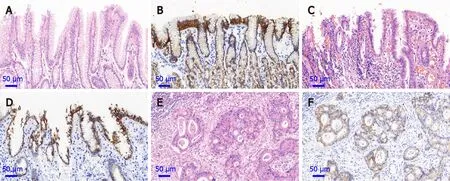

Association of E-cadherin expression with clinicopathological features in patientswith GCA
By comparing the relationship between E-cadherin expression and clinicopathological characteristics,the expression rate of E-cadherin in male patients was lower than that in female patients (83.5
86.4%,χ
=4.645,
=0.031,Table 3).It was found that the positive rate of E-cadherin expression gradually decreased with the degree of differentiation (92.5%
85.4%
82.5%,χ
=14.259,
=0.001,Table 3).E-cadherin expression differed according to degree of tumor invasion (χ
=22.490,
<0.001,Table 3).The Ecadherin positive immunostaining rate was significantly higher in the patients at early stage (0 and I) than advanced stage (II and III) (92.7%
83.7%,χ
=10.941,
=0.001,Table 3).There was no significant difference in the expression of E-cadherin protein according to age at diagnosis,family history,cigarette smoking,alcohol consumption and lymph node metastasis (
>0.05,Table 3).
E-cadherin expression is an independent risk factor for GCA prognosis
To evaluate the potential association of clinical factors with overall survival,we performed univariate Cox regression analysis.In univariate analysis,age at diagnosis (
<0.001),degree of differentiation (
<0.001),invasion depth (
<0.001),lymph node metastasis (
<0.001) and E-cadherin expression (
=0.003) were survival factors(Table 4).There was no significant difference in overall survival among patients with different gender,family history,cigarette smoking and alcohol consumption (Table 4).Kaplan–Meier analysis showed that positive E-cadherin expression predicted better overall survival (
=0.003;Figure 3A).Similarly,it showed that age<60 years at diagnosis,well differentiation,T1 and negative lymph node metastasis predicted better overall survival (
<0.001;Supplementary Figure 1).In multivariate analysis,Ecadherin expression was an independent factor of GCA survival (
=0.026;Table 4).

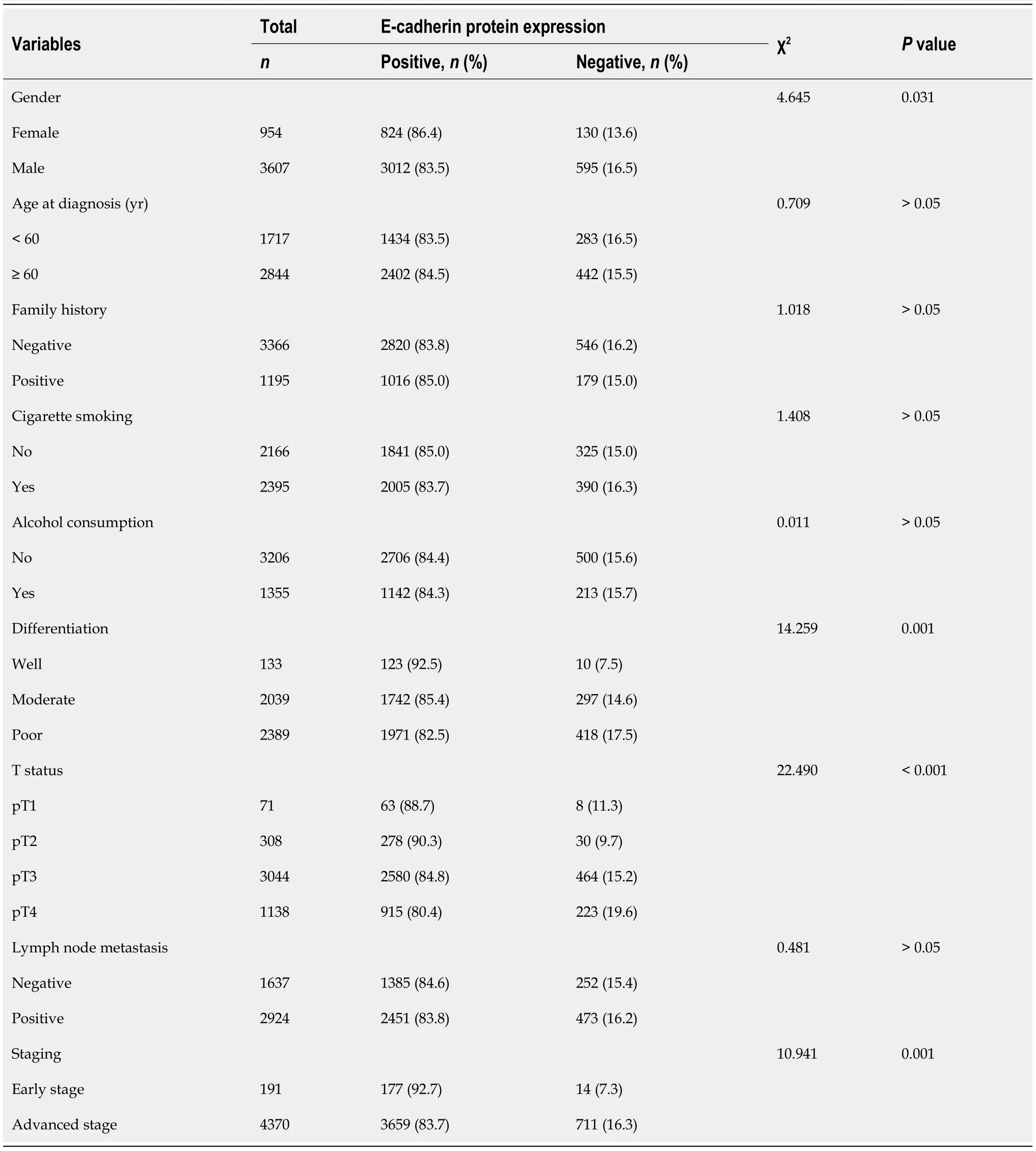
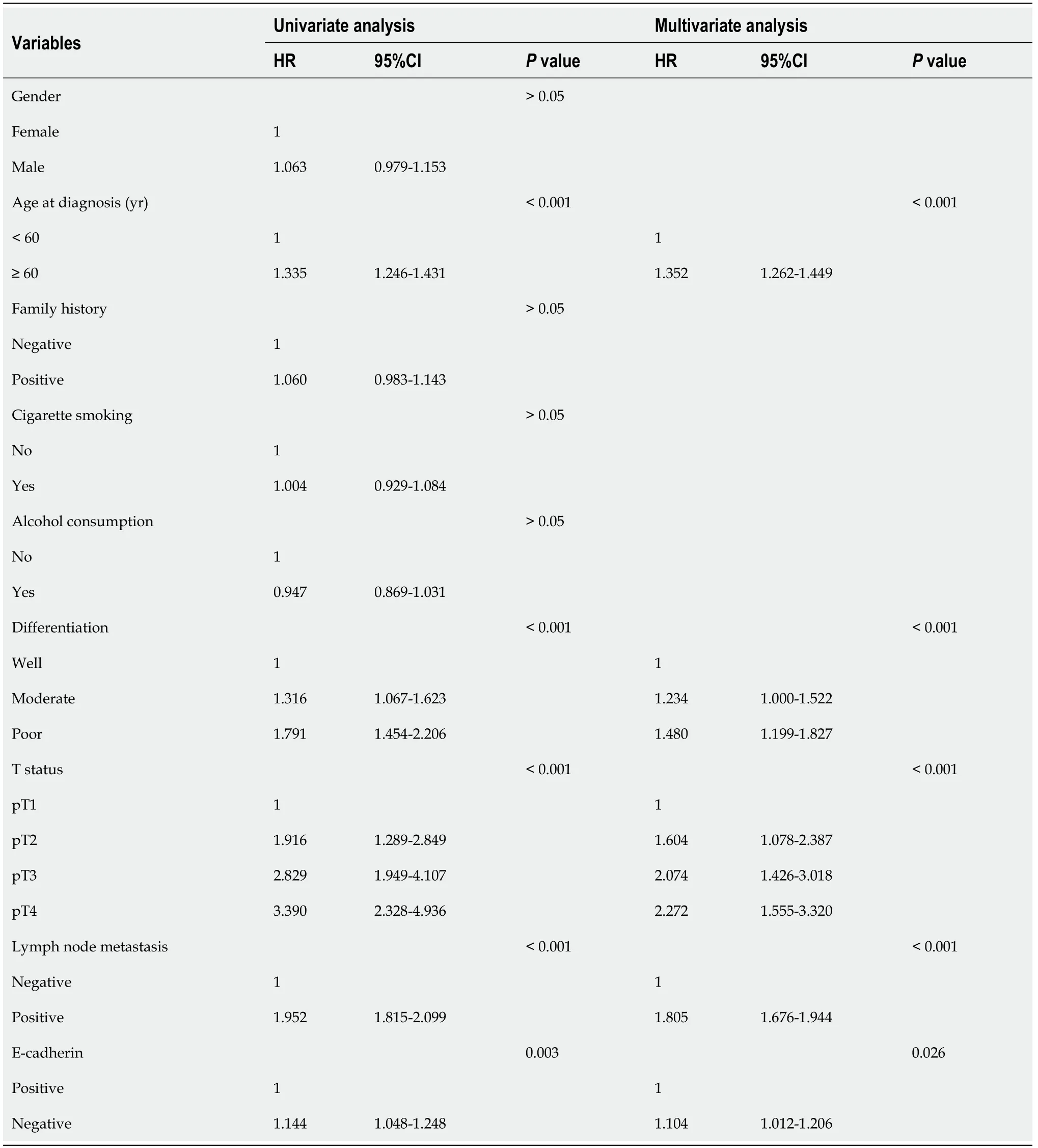
Stratification analysis of the effect of E-cadherin expression on patient survival
According to the clinicopathological features,the patients were divided into different groups.In the group with negative lymph node metastasis,survival was better in patients with positive E-cadherin expression than negative expression (
=0.036;Figure 3B).A similar result was found in the group with positive lymph node metastases (
=0.048;Figure 3C).With regard to the patients at advanced stage (II and III),patients with positive E-cadherin expression survived better than those with negative expression (
=0.011;Figure 3D).
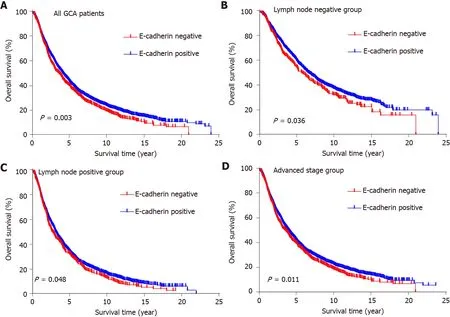
DISCUSSION
As we know,the present study is the first report about the E-cadherin protein expression in the lesions progressed from normal gastric cardia mucosa to dysplasia and GCA,and the largest sample study of the expression of E-cadherin protein and its influence on survival with GCA[13,14].
It is well known that loss of E-cadherin expression resulting from CDH1 gene alterations is the primary carcinogenetic event in hereditary diffuse gastric cancer[15].However,there was few report concerning the expression of E-cadherin in the gastric cardia carcinogenesis,progressed from normal gastric cardia to dysplasia and GCA.It is showed that,in our study,the significantly decreased immunostaining rate of Ecadherin protein presented from normal gastric cardia to dysplasia and GCA,which indicated that E-cadherin protein may be involved in the gastric cardia carcinogenesis and low expression of E-cadherin protein may accelerate the process.The result in our study was consistent with those reported on gastric cancer[16].
It was found that the positive rate of E-cadherin expression gradually decreased with the decline of the degree of differentiation (92.5%
85.4%
82.5%,χ
=14.259,
=0.001).The worse the differentiation,the lower the positive expression rate of Ecadherin.This is consistent with previous studies[17,18].We think that E-cadherin may be a differentiation marker.
The present study demonstrated that patients with positive expression of Ecadherin protein had better survival than those with negative expression.Cox regression analysis indicated that positive expression of E-cadherin protein was an independent factor for better prognosis of patients with GCA,considered together with age at diagnosis,degree of differentiation,invasion depth and lymph node metastasis.The mechanism for the E-cadherin expression and cancer prognosis is largely unknown.E-cadherin gene,also known as CDH1,has been recognized as a tumor suppressor gene.Decreased expression of E-cadherin is reported to be related to prognosis in breast,colorectal and hepatocellular cancers[19,20].However,less research has been conducted on GCA and controversial results have been observed in gastric cancer[21,22].A meta-analysis of E-cadherin expression in 4383 patients with gastric cancer showed that the down-regulation of E-cadherin expression was significantly correlated with TNM stage,tumor invasion depth,lymph node metastasis,tumor differentiation,vascular invasion,tissue type and distant metastasis[23].This study showed that negative E-cadherin was associated with poor differentiation and deep invasion of tumors,which suggested that tumor differentiation was related to cell adhesion,while tumors lacking adhesion were prone to regional lymph node or distant metastasis and had a relatively poor prognosis.The results of our study did not indicate that E-cadherin was associated with lymph node metastasis of GCA,which still needs to be confirmed by further studies.
Another interesting finding in the present study was that positive expression of Ecadherin protein in GCA patients at dysplasia lesion was higher than in GCA stage(93%
84.1%,
=0.003),which indicates that E-cadherin protein may be an early potential biomarker for gastric cardia carcinogenesis.Accumulated evidence demonstrates that the germline mutations of E-cadherin gene are highly correlated with hereditary diffuse gastric cancer and lobular breast cancer,and are considered to be promising biomarkers,combined with endoscopy,for early detection of hereditary diffuse gastric cancer and breast cancer[26-29].
He longed to get to it, but how? neither road nor bridge was anywhere to be seen, yet the city drew him upwards26, and he felt that here at last was the country which he sought
Disruption of the cell adhesion molecule E-cadherin causes dysregulation of cell–cell adhesion properties.E-cadherin expression may be associated with epithelial–mesenchymal transition through activating the Akt and mitogen-activated protein kinase signaling pathways[24],and negative expression of E-cadherin could lead to a decline of proliferation and metastasis.Medicines for CDH1 mutations are being developed and it has been suggested that non-steroidal anti-inflammatory drugs can inhibit CDH1 methylation in human gastric mucosa[25].
I believe I m breaking up! The whole day the Snow-man looked through the window; towards dusk the room grew still more inviting28; the stove gave out a mild light, not at all like the moon or even the sun; no, as only a stove can shine, when it has something to feed upon
E-cadherin protein expression was detected by immunohistochemical staining on normal mucosa,dysplasia and GCA with tissue microarray.The focal area of the cancer tissue was marked on the paraffin-embedded specimens,and a 7 × 16 microarray was designed.Punch holes with a diameter of 1.5 mm were made in the samples.The tissue chip model was then made and fixed.Immunohistochemistry was carried out by a two-step protocol using the Roche Benchmark XT.In brief,the paraffin-embedded tissue sections were deparaffinized with xylene and anhydrous ethanol for rehydration and heated in citrate buffer (G1202,pH 6.0) for 25 min at 95 ℃for antigen repair.The sections were then cooled for 60 min at room temperature,and immersed in 3% hydrogen peroxide solution (G0115) to neutralize endogenous peroxidase.A mouse monoclonal anti-E-cadherin antibody was used (cat.no.GB13083-1;dilution 1:500;Wuhan Servicebio Technology Co.,Ltd,Wuhan,China).The anti-E-cadherin antibody was added and incubated overnight at 4 ℃.The secondary antibody was then added (cat.no.G1210-2).Between each incubation step,the slides were washed with phosphate buffered saline (PBS,pH 7.4,G0002) three times.Immunostaining was performed using the Roche Benchmark XT with diaminobenzidine (DAB,G1212-200) according to the manufacturer’s instructions and the sections were subsequently counterstained with hematoxylin (G1004).The known positive sections were used as the positive control,and PBS was used as the negative control instead of the primary antibody.Observation was performed using a microscope at a magnification of 400 ×.The positive cells for E-cadherin protein expression showed yellow or brown staining in the cell membrane.
This study has some limitations.Firstly,there might be some missing data about clinical information.Secondly,the patients’ time span was long and the fact that they came from different hospitals also might have caused some bias.Further studies are needed to confirm the new findings.
CONCLUSION
From the clinical records,we retrieved the baseline clinical parameters for this group of GCA patients (Table 1).It shows the distribution of all GCA patients by gender,age,family history,cigarette smoking,alcohol consumption and histopathology.Among the 4561 patients with GCA,there were 954 women and 3607 men with a mean age of 61.6 ± 8.8 and 61.9 ± 8.6,respectively.The number of male patients was 3.8 times that of female patients.Family aggregation for GCA patients was evident with a positive family history in 26.2% of the patients.In addition,2395 (52.5%) patients had a history of cigarette smoking and 1355 (29.7%) patients had a history of alcohol consumption.Among male patients,65.7% (2370/3607) had a history of smoking and 36.8%(1327/3607) had alcohol consumption.The depth of invasion and lymph node metastasis were also classified.There were 2924 (64.1%) patients with positive lymph node metastasis in postoperative pathology.There were 191 (4.2%) patients at early stage (0 and I) and 4370 (95.8%) patients at advanced stage (II and III).
ARTICLE HIGHLIGHTS
Research background
The staged of patients with GCA were based on the 8
edition of the American Joint Committee.Positive smoking history was defined as having smoked continuously or accumulatively for 6 mo or more in one's lifetime and negative drinking history was defined less than 20 g of alcohol
day.Family history positive was defined as more than two patients with GCA in two consecutive generations.
Research motivation
The positive immunostaining reaction of E-cadherin protein expression was mainly located in the cell membrane (Figure 1).With the lesions progressed from normal gastric cardia mucosa to dysplasia and GCA,the positive immunostaining rates for Ecadherin decreased significantly from 100.0% (208/208),to 93.0% (145/156) and 84.1%(3836/4561),respectively (χ
=47.439,
<0.001;Table 2).In the linear analysis of Ecadherin protein expression in normal mucosa,dysplasia and GCA,the decreasing tendency was observed (y=-0.08x + 1.0833,R
=0.9948,Figure 2).
Research objectives
This study aimed to characterize E-cadherin expression in normal gastric cardia epithelium,dysplasia lesions and GCA tissues,and its influence on prognosis for GCA.
Research methods
Immunochemistry stating of E-cadherin was performed on GCA and matched adjacent normal epithelial tissue and dysplasia.The correlation on E-cadherin protein expression and prognosis of patients with GCA were analyzed using Kaplan–Meier and Cox regression test.
Research results
With the lesions progressed from normal gastric cardia mucosa to dysplasia and GCA,the positive immunostaining rates for E-cadherin decreased significantly from 100% to 93.0% and 84.1%,respectively (R2=0.9948).E-cadherin had better survival than those with negative expression (P=0.026).In the group with negative lymph node metastasis,survival was better in patients with positive E-cadherin expression than negative expression (P=0.036).Similarly,in patients with late stage GCA,those with positive expression of E-cadherin had better survival than those with negative expression (P=0.011).
The passengers on the bus watched sympathetically as the young woman with the white cane1 made her way carefully up the steps. She paid the driver and then, using her hands to feel the location of the seats, settled in to one. She placed her briefcase2 on her lap and rested her cane against her leg.
Research conclusions
E-cadherin expression may be involved in gastric cardia carcinogenesis and low expression of E-cadherin may be a promising early biomarker and overall survival predictor for GCA.
To make money! I pointed18 at the bundle of dollar bills he was carrying. Because of the storm, nobody else had caught a fish, so Benny had won the jackpot.
Research perspectives
E-cadherin protein expression is expected to be a molecular marker for early detection and prognosis prediction for GCA.
But do not men sometimes act quite as cruelly towards theirown fellow-men? Was not the knight Sir Bugge murdered by wickedpeople? And though he was well spoken of, did he not also wish to kill the architect who built the castle for him, with its thick walls andtower, at the point where the Skjaerumaa falls into the bay? Jurgenand his parents now stood there; the wall and the ramparts stillremained, and red crumbling fragments lay scattered around
Then all the old people came and asked for work, and he answered cheerfully, Oh, yes, there is plenty for everybody; and when the boys begged to be allowed to help he found something that they could do
We thank Professor Xue-Zhong Shi (Department of Epidemiology and Biostatistics,College of Public Health,Zhengzhou University) for help in statistical analysis.
1 Bray F,Ferlay J,Soerjomataram I,Siegel RL,Torre LA,Jemal A.Global cancer statistics 2018:GLOBOCAN estimates of incidence and mortality worldwide for 36 cancers in 185 countries.
2018;68:394-424 [PMID:30207593 DOI:10.3322/caac.21492]
2 Chen H,Wang LD,Guo M,Gao SG,Guo HQ,Fan ZM,Li JL.Alterations of p53 and PCNA in cancer and adjacent tissues from concurrent carcinomas of the esophagus and gastric cardia in the same patient in Linzhou,a high incidence area for esophageal cancer in northern China.
2003;9:16-21 [PMID:12508343 DOI:10.3748/wjg.v9.i1.16]
3 Arnold M,Laversanne M,Brown LM,Devesa SS,Bray F.Predicting the Future Burden of Esophageal Cancer by Histological Subtype:International Trends in Incidence up to 2030.
2017;112:1247-1255 [PMID:28585555 DOI:10.1038/ajg.2017.155]
4 Dubecz A,Solymosi N,Stadlhuber RJ,Schweigert M,Stein HJ,Peters JH.Does the Incidence of Adenocarcinoma of the Esophagus and Gastric Cardia Continue to Rise in the Twenty-First Century?
2013 [PMID:24234242 DOI:10.1007/s11605-013-2345-8]
5 Liu K,Yang K,Zhang W,Chen X,Zhang B,Chen Z,Chen J,Zhao Y,Zhou Z,Chen L,Hu J.Changes of Esophagogastric Junctional Adenocarcinoma and Gastroesophageal Reflux Disease Among Surgical Patients During 1988-2012:A Single-institution,High-volume Experience in China.
2016;263:88-95 [PMID:25647058 DOI:10.1097/SLA.0000000000001148]
6 Buas MF,Vaughan TL.Epidemiology and risk factors for gastroesophageal junction tumors:understanding the rising incidence of this disease.
2013;23:3-9 [PMID:23207041 DOI:10.1016/j.semradonc.2012.09.008]
7 Wheelock MJ,Johnson KR.Cadherins as modulators of cellular phenotype.
2003;19:207-235 [PMID:14570569 DOI:10.1146/annurev.cellbio.19.011102.111135]
8 Bure IV,Nemtsova MV,Zaletaev DV.Roles of E-cadherin and Noncoding RNAs in the Epithelialmesenchymal Transition and Progression in Gastric Cancer.
2019;20:2870 [PMID:31212809 DOI:10.3390/ijms20122870]
9 Ishiguro H,Wakasugi T,Terashita Y,Sakamoto N,Tanaka T,Mizoguchi K,Sagawa H,Okubo T,Takeyama H.Decreased expression of CDH1 or CTNNB1 affects poor prognosis of patients with esophageal cancer.
2016;14:240 [PMID:27600761 DOI:10.1186/s12957-016-0956-8]
10 Lin Y,Shen LY,Fu H,Dong B,Yang HL,Yan WP,Kang XZ,Dai L,Zhou HT,Yang YB,Liang Z,Chen KN.P21,COX-2,and E-cadherin are potential prognostic factors for esophageal squamous cell carcinoma.
2017;30:1-10 [PMID:27868288 DOI:10.1111/dote.12522]
11 Bruun J,Kolberg M,Nesland JM,Svindland A,Nesbakken A,Lothe RA.Prognostic Significance of β-Catenin,E-Cadherin,and SOX9 in Colorectal Cancer:Results from a Large Population-Representative Series.
2014;4:118 [PMID:24904831 DOI:10.3389/fonc.2014.00118]
12 Giroux V,Rustgi AK.Metaplasia:tissue injury adaptation and a precursor to the dysplasia-cancer sequence.
2017;17:594-604 [PMID:28860646 DOI:10.1038/nrc.2017.68]
13 Polkowski WP,Skomra DG,Mielko J,Wallner GT,Szumi?o J,Zinkiewicz K,Korobowicz EM,van Lanschot JJ.E-cadherin expression as predictive marker of proximal resection line involvement for advanced carcinoma of the gastric cardia.
2004;30:1084-1092 [PMID:15522555 DOI:10.1016/j.ejso.2004.07.022]
14 Wijnhoven BP,Tucker ET,Dinjens WN,Tilanus HW,Pignatelli M.Biochemical analysis and subcellular distribution of E-cadherin-catenin in adenocarcinomas of the gastro-oesophageal junction.
2004;24:1369-1375 [PMID:15274297]
15 Yakirevich E,Resnick MB.Pathology of gastric cancer and its precursor lesions.
2013;42:261-284 [PMID:23639640 DOI:10.1016/j.gtc.2013.01.004]
16 Zhou YN,Xu CP,Han B,Li M,Qiao L,Fang DC,Yang JM.Expression of E-cadherin and betacatenin in gastric carcinoma and its correlation with the clinicopathological features and patient survival.
2002;8:987-993 [PMID:12439911 DOI:10.3748/wjg.v8.i6.987]
17 Corso G,Figueiredo J,De Angelis SP,Corso F,Girardi A,Pereira J,Seruca R,Bonanni B,Carneiro P,Pravettoni G,Guerini Rocco E,Veronesi P,Montagna G,Sacchini V,Gandini S.E-cadherin deregulation in breast cancer.
2020;24:5930-5936 [PMID:32301282 DOI:10.1111/jcmm.15140]
18 Graziano F,Humar B,Guilford P.The role of the E-cadherin gene (CDH1) in diffuse gastric cancer susceptibility:from the laboratory to clinical practice.
2003;14:1705-1713 [PMID:14630673 DOI:10.1093/annonc/mdg486]
19 Padmanaban V,Krol I,Suhail Y,Szczerba BM,Aceto N,Bader JS,Ewald AJ.E-cadherin is required for metastasis in multiple models of breast cancer.
2019;573:439-444 [PMID:31485072 DOI:10.1038/s41586-019-1526-3]
20 Wong SHM,Fang CM,Chuah LH,Leong CO,Ngai SC.E-cadherin:Its dysregulation in carcinogenesis and clinical implications.
2018;121:11-22 [PMID:29279096 DOI:10.1016/j.critrevonc.2017.11.010]
21 Sun S,Gong Q.The expressions and prognostic implications of Twist and E-cadherin in adenocarcinomas of the gastroesophageal junction and proximal gastric carcinoma.
2019;98:e18449 [PMID:31876727 DOI:10.1097/MD.0000000000018449]
22 Schizas D,Moris D,Michalinos A,Kanavidis P,Oikonomou D,Papalampros A,Machairas A,Liakakos T.E-cadherin in gastric carcinomas:Relations with histological parameters and its prognostic value.
2017;22:383-389 [PMID:28534359]
23 Hu L,Li HL,Li WF,Chen JM,Yang JT,Gu JJ,Xin L.Clinical significance of expression of proliferating cell nuclear antigen and E-cadherin in gastric carcinoma.
2017;23:3721-3729 [PMID:28611525 DOI:10.3748/wjg.v23.i20.3721]
24 Reddy P,Liu L,Ren C,Lindgren P,Boman K,Shen Y,Lundin E,Ottander U,Rytinki M,Liu K.Formation of E-cadherin-mediated cell-cell adhesion activates AKT and mitogen activated protein kinase
phosphatidylinositol 3 kinase and ligand-independent activation of epidermal growth factor receptor in ovarian cancer cells.
2005;19:2564-2578 [PMID:15928314 DOI:10.1210/me.2004-0342]
25 Tahara T,Shibata T,Nakamura M,Yamashita H,Yoshioka D,Okubo M,Maruyama N,Kamano T,Kamiya Y,Fujita H,Nagasaka M,Iwata M,Takahama K,Watanabe M,Hirata I,Arisawa T.Chronic aspirin use suppresses CDH1 methylation in human gastric mucosa.
2010;55:54-59[PMID:19184424 DOI:10.1007/s10620-008-0701-4]
26 Xing X,Tang YB,Yuan G,Wang Y,Wang J,Yang Y,Chen M.The prognostic value of E-cadherin in gastric cancer:a meta-analysis.
2013;132:2589-2596 [PMID:23169395 DOI:10.1002/ijc.27947]
27 Curtin BF,Gamble LA,Schueler SA,Ruff SM,Quezado M,Miettinen M,Fasaye GA,Passi M,Hernandez JM,Heller T,Koh C,Davis JL.Enhanced endoscopic detection of occult gastric cancer in carriers of pathogenic CDH1 variants.
2021;56:139-146 [PMID:33206267 DOI:10.1007/s00535-020-01749-w]
28 Pilonis ND,Tischkowitz M,Fitzgerald RC,di Pietro M.Hereditary Diffuse Gastric Cancer:Approaches to Screening,Surveillance,and Treatment.
2021;72:263-280 [PMID:33217247 DOI:10.1146/annurev-med-051019-103216]
29 Memni H,Macherki Y,Klayech Z,Ben-Haj-Ayed A,Farhat K,Remadi Y,Gabbouj S,Mahfoudh W,Bouzid N,Bouaouina N,Chouchane L,Zakhama A,Hassen E.E-cadherin genetic variants predict survival outcome in breast cancer patients.
2016;14:320 [PMID:27852262 DOI:10.1186/s12967-016-1077-4]
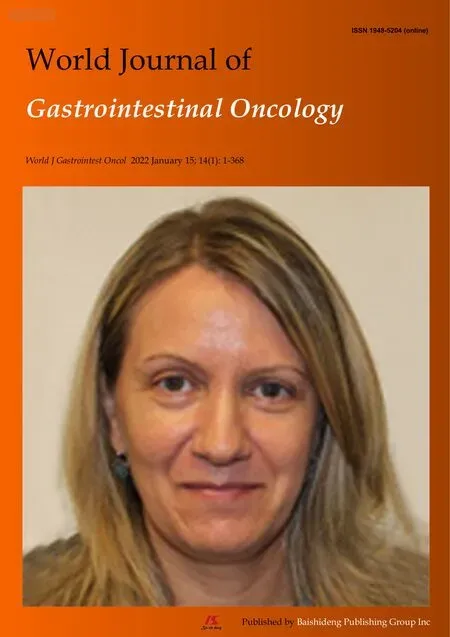 World Journal of Gastrointestinal Oncology2022年1期
World Journal of Gastrointestinal Oncology2022年1期
- World Journal of Gastrointestinal Oncology的其它文章
- Comment on “Outcomes of curative liver resection for hepatocellular carcinoma in patients with cirrhosis”
- Liquid biopsy:Precise diagnosis and therapy for cholangiocarcinoma
- Increased risk of colorectal neoplasia in inflammatory bowel disease patients with post-inflammatory polyps:A systematic review and meta-analysis
- Exosomes as potential diagnosis and treatment for liver cancer
- Effects of cognitive behavior therapy combined with Baduanjin in patients with colorectal cancer
- Intertwined leukocyte balances in tumours and peripheral blood as robust predictors of right and left colorectal cancer survival
